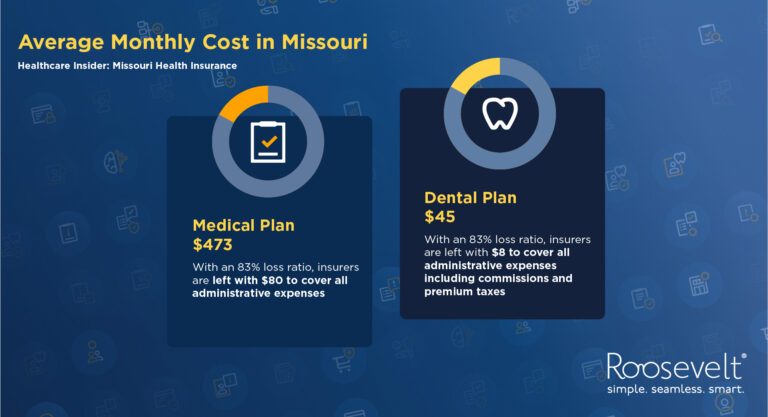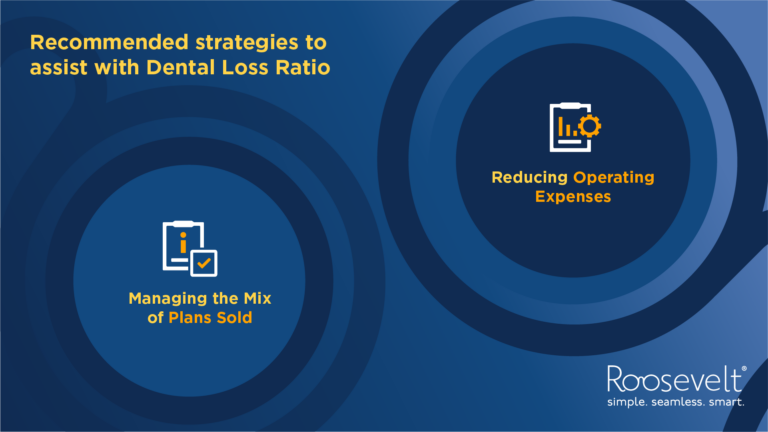Dental carriers face significant challenges with new laws and regulations that mandate minimum Dental Loss Ratios (DLRs). While the intent of these laws and regulations may be to protect consumers, compliance may pose challenges to insurance carriers. This article delves into DLR, how minimum DLR mandates may affect carriers and policyholders, and strategies for carriers to comply with minimum DLR mandates while maintaining strong business performance.
Understanding Dental Loss Ratio
Dental Loss Ratio (DLR) is a measure (percentage) of the amount a dental carrier pays out in claims and related expenses compared to the amount of money the company receives in premiums from policyholders.
A simple example:
If a carrier collects $100 in premiums and pays out $75 in dental claims, the Dental Loss Ratio (DLR) is 75%. This means that for every dollar in premium the company receives, 75 cents is paid in claims.
Some states have started mandating a minimum DLR carriers must meet. For example, Massachusetts became the first state to pass a ballot initiative establishing a minimum 83% DLR for dental plans. If a carrier’s loss ratio falls below 83%, it must provide rebates to policyholders. Before this, no other states had a minimum DLR with required rebates, although California and Maine did have DLR reporting requirements.
Navigate to our “Resources” section at the bottom of the page to learn more about which states are implementing this change and where they are in the ballot process.
Unfortunately, it appears that policymakers and legislators are using established Medical Loss Ratios (MLRs) as the starting point for mandated DLRs. While medical and dental carriers have similar administrative and compliance needs (which translate to similar administrative expenses), they have very different premiums and claim costs. A high loss ratio (such as 83%) may be reasonable for a medical plan with its naturally higher premiums. However, that same, high loss ratio does not make economic sense for a dental plan with its much lower premiums.
To illustrate, let’s look at average premium costs in Missouri:

Source: Healthcare Insider: Missouri Health Insurance
Clearly, scale matters when it comes to loss ratios. Rigid DLR mandates that don’t account for the differences between medical and dental plans could have unintended consequences, including negatively impacting dental insurance affordability and availability. Carriers need solutions that allow them to meet requirements without compromising the quality of care.
How Dental Carriers Can Adapt to Mandated Dental Loss Ratios
We propose viewing DLR mandates as an opportunity to optimize. Carriers should look for ways to significantly reduce administrative costs by streamlining internal processes and adopting new technology. They should consider how internal business and technology changes could create room to maintain or even lower premiums while still hitting DLR targets.
The key is to focus on operational efficiency first before passing higher costs to customers. With more intelligent workflows and automation, dental plans can share efficiency gains as savings with their customers.
The Roosevelt Platform Can Help Dental Carriers Transform Operations and Meet DLR Mandates
Incorporating over 65 years of dental claims processing experience, Roosevelt delivers automation, accuracy, capabilities, and expertise for dental carriers to transform their operations and bring new and innovative benefits to the market.
The Roosevelt platform supports many strategies a payer could choose when dealing with DLR compliance issues. We’ve internally identified several strategies to combat these mandates, but here we will specifically focus on two of them: managing the mix of plans sold and reducing operating expenses.
Managing the Mix of Plans Sold
One advantage of offering a variety of benefit plans is that it should be an easy strategy to implement. With the right administration platform, such as Roosevelt, that is easily configurable. Offering plans with more comprehensive coverage will likely increase utilization as members can better afford care. That increased utilization helps lift total spending on clinical services and quality initiatives, thus raising DLR. Promoting plans with richer benefits is a compelling long-term strategy to help comply with DLR mandates.
Reducing Operating Expenses
There are various initiatives carriers can undertake to reduce operational expenses and overhead. One practical approach is to upgrade from outdated legacy systems to modern, established insurance software solutions such as Roosevelt. Maintaining old technology is increasingly expensive due to reliance on technical maintenance and the risks associated with aging systems. While building entirely new systems in-house could allow customization, that approach requires considerable investments in software development which often diverts focus and resources away from core insurance business.

Instead, transitioning to a ready-to-use insurance platform like Roosevelt with robust capabilities can significantly cut costs compared to maintaining or building from scratch. Reduced spending on operational overhead directly improves dental loss ratio.
Partnering with an industry-leading software vendor like Roosevelt to implement an integrated platform can help the bottom line while demonstrating efficient management of premium dollars under the new regulations.
Overcoming Dental Loss Ratio Challenges
Mandated Dental Loss Ratios (DLRs) present a significant compliance challenge for insurance carriers. However, with the right strategy and tools, it is possible to navigate DLR mandates successfully while maintaining customer satisfaction.
Adopting transformative technology like Roosevelt’s can lower operating costs and help manage the mix of plans sold which both lead to compliance with DLR targets. The net effect may even result in lowering premiums while increasing utilization; that works for everyone.
The outcome is a win-win situation for dental carriers, their customers, and their providers. With Roosevelt as a transformation partner, dental carriers can efficiently and effectively meet the DLR challenge and continue delivering robust results.
Get Started Today
Contact us today to learn more about how Roosevelt can help you meet DLR mandates and propel your organization to new heights of efficiency and profitability. Our team is ready to partner with you for transformation success.
Resources
DLR State Activity:
The following is not an exhaustive list of DLR legislation or entire bill details.
Additional Resources:


